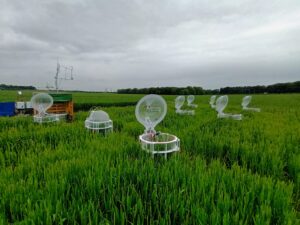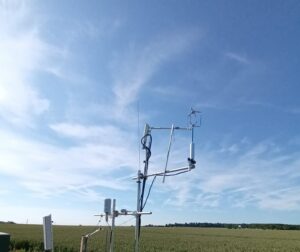Regenerative Agriculture for Net-Zero
Regenerative Agriculture for Net-Zero
Dr Richard Grayson (School of Geography, University of Leeds), Prof. P. Chapman (School of Geography, University of Leeds), Dr Ruth Wade (School of Biology, University of Leeds) & Dr Ross Morrison (UK Centre for Ecology and Hydrology)
Project Summary
Current agricultural practices have been incredibly successful at supporting rapid global human population growth but this has come at a significant cost to the environment. Agriculture and food production are responsible for 26% of global human-induced greenhouse gas emissions (GHG), whilst simultaneously contributing to water and air pollution and as the primary driver of biodiversity loss. There has never been a more pressing time to develop better ways of producing food that can also regenerate the environment by reversing these negative impacts. Agriculture is one of the few sectors with the potential to make a significant contribution to achieving Net Zero global ambitions, by reducing GHG emissions from agricultural production as well as capturing and storing (sequestering) more carbon in natural sinks such as farm soils and vegetation.
Regenerative agriculture (RA) as a farmer-led movement is gaining traction. It potentially offers an approach to farming that reduces and/or reverses environmental impacts through soil health improvements that in turn deliver GHG emissions reductions and increased soil carbon storage, whilst maintaining a profitable farm business. Such RA farming practices include minimal or zero tillage, cover crops, addition of organic amendments, more diverse crop selection, and inclusion of livestock, amongst others. In the UK, each devolved authority is developing post-Brexit national agri-environment schemes (e.g., Environmental Land Management schemes (ELMs) in England) that prioritise delivery of public goods and services. It is anticipated that 75% of farms in England will engage in low carbon farming practices by 2030, increasing to 85% by 2035. However, despite the UK government’s commitment and a growing sectoral shift towards RA, there remains a lack of evidence-based practice, particularly on UK soils, with a significant lack of real-world data on GHG fluxes and carbon sequestration within RA systems. As such, there is a real need to better understand the role of different agricultural practices on GHG fluxes and C sequestration across agricultural systems in the UK.
With direct ownership of a 320 hectare commercial farm, the University of Leeds is perfectly placed to deliver cutting-edge research on the transition towards RA, including large replicated field trials comparing regenerative and conventional farm practices. Building on this research, supported through a large and engaged local farming network together with the University of Leeds farms state of the art facilities and equipment (such as automated GHG chambers and eddy covariance towers) this project will deliver data to inform and shape an evidence-based transition towards RA practices and the global net zero goal.


Aims and Objectives
This project offers an exciting opportunity to make a significant contribution to shaping the future of agriculture during the transition towards net zero. Building on our existing datasets and trials, the project uses state of the art facilities and equipment at the University of Leeds farm and laboratories to measure GHG emissions and carbon storage of RA systems using long-term eddy covariance (EC) measurements and automatic chamber experiments.
The studentship will address a combination of topic areas, including:
- Impacts of regenerative agricultural practices on GHG fluxes and soil carbon sequestration
- The net ecosystem carbon balance of the most widespread and novel UK agricultural crops
- Land-Air fluxes of water, carbon and nitrogen using eddy covariance flux towers and automatic chambers
- The detailed environmental processes that control biogeochemical cycles in agricultural systems
Training
The student will work under the supervision of Dr Richard Grayson and Professor Pippa Chapman within the Faculty of Environment, University of Leeds, Dr Ruth Wade within the Faculty of Biological Sciences, University of Leeds, plus Dr Ross Morrison at the UK Centre for Ecology and Hydrology (UKCEH), who have expertise in all aspects of the project. Fieldwork will be conducted in the UK, and the findings will be of international relevance. The student will have access to excellent training and field and laboratory resources at the University of Leeds and UKCEH. This includes the School of Geography laboratories which are equipped to prepare and measure, gas, water and soil samples. The student will also have access to the University of Leeds research farm building on the already installed regenerative agricultural trials, have the use of three eddy covariance flux towers which focus on observing land-atmosphere fluxes of carbon dioxide (CO2) and water vapour (evapotranspiration and access to a soil GHG flux chamber system with an analyser that is capable of measuring CO2, CH4, N2O and H2O and mobile gas analysers capable of measuring many gases including CO2, CH4,N2O and H2O. In addition, the student will join UKCEHs wider network of eddy covariance flux across the UK and Europe, combining spatially distributed datasets to inform policy and practice.
The successful candidate will develop a range of research skills, including experimental design, field sampling, statistical analysis and data interpretation, modelling, academic writing skills and giving presentations. Training will be provided in field and laboratory health and safety procedures and the use of field and analytical equipment.
